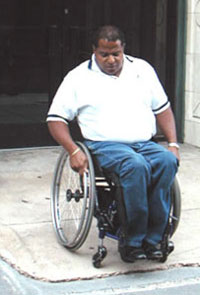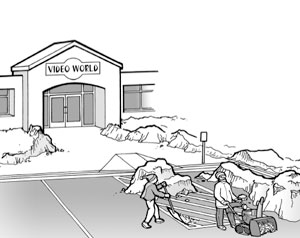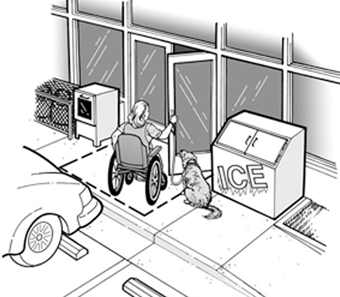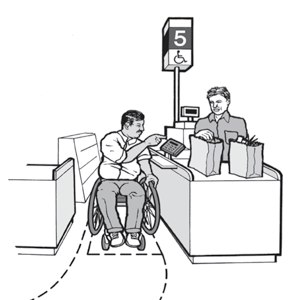| U.S. Department of Justice Civil Rights Division Disability Rights Section |
|
Expanding |
Maintaining Accessible Features |
| Your Market |
in Retail Establishments |
|
More than 50 million Americans with disabilities are potential customers for retail businesses across the country. These 50-million-plus customers, along with their families and friends, patronize clothing boutiques, mall outlets, grocery stores, and more, if the businesses are accessible. This market grows even larger if the 78 million baby boomers in this country - who do not always require but benefit from accessibility - are included. Accessibility makes good business sense: an accessible retail establishment brings in new customers and keeps them coming back again and again. The Americans with Disabilities Act (ADA) requires businesses that serve the public to remove barriers from older buildings and to design and build new facilities to provide access to customers with disabilities. A key component of ADA compliance is maintaining those features so they remain usable. Businesses spend money to remove barriers. And, businesses need to protect that investment. Even brand-new buildings designed for complete accessibility can become inaccessible without proper attention. If key elements - often including the parking, building entrance, route into and through the establishment, access to the store's goods and services, restrooms, cashier stations, and egress - are not maintained, then access is reduced or eliminated. A poorly placed trashcan or a locked door can make a building unusable. Now that is a waste of money. This document identifies ways that businesses can maintain their investment in access with little or no extra cost. Issues will vary, of course, with individual retail establishments. |
Inoperable elevators, locked accessible doors, or routes that are obstructed by furniture or merchandise make buildings inaccessible to and unusable by customers with disabilities. |
Visit the U.S. Department of Justice's ADA Business Connection website at archive.ada.gov for more information about accessibility in retail establishments, including "Reaching Out to Customers with Disabilities," the Department's ADA online course.
Accessible Parking
In order for an accessible parking space to be usable, all elements of the space must be free of obstructions: the vehicle space, the access aisle, the curb ramp, and the route that connects the parking to the accessible entrance of the building. Lack of maintenance of any one of those elements can make the whole space inaccessible. For example, for a wheelchair user to exit her car, she must place her wheelchair in the access aisle, transfer from the car seat to her wheelchair, and then roll backward in the access aisle to provide clearance to close the car door. If another car parks in the aisle or if a plow loads the aisle with snow, the wheelchair user does not have sufficient room to get out of her car. That parking space the owner just paid to have correctly restriped is now useless to her. Maintenance List
|
Accessible Route Into and Through the Business
|
Accessible Restrooms, Fitting Rooms, and Elevators
Equally important to the customer experience is the ability to move comfortably within the establishment and to try out or try on the merchandise. Maintenance of accessible restrooms and fitting rooms, customer service and product demonstration areas, and lifts and elevators is essential for all customers to fully enjoy the shopping experience and buy merchandise.
Maintenance List
- Unlock accessible public restrooms, toilet stalls, and fitting rooms and make sure they are available to customers with disabilities during business hours. They cannot be used as temporary storage areas or staff locker space.
- Eliminate furniture or equipment, such as shelving, large trashcans, and chairs, that take up required maneuvering space in fitting rooms and restrooms.
- Routinely refill the accessible paper towel and soap dispensers when all other dispensers are refilled.
- Maintain lifts and elevators regularly. Repair them whenever necessary, and return them to service as quickly as possible.
- Remove trash receptacles and cigarette urns from under elevator hall call buttons and beside doors to ensure access to controls and sufficient maneuvering clearance.
Accessible Customer Information
Alternate formats of printed information for customers have to be kept up to date to be useful. Offering a Braille brochure with old telephone numbers or a large-print equipment rental application with wrong rental return requirements will only frustrate and confuse customers.
One way to maintain accessible features is to consistently educate all staff about them. Tell employees the location and purpose of accessible retail elements and impress upon them the importance of keeping the features usable. Provide employees with procedures for correcting problems. Together staff can ensure that the store's investment in accessibility brings the greatest possible return.
| Checklist for Maintaining Accessible Features | |
Date of completion of the last checklist: ________________________________________ Name of person completing the current checklist: ________________________________ Date of completion of the current checklist: ____________________________________
|
|
| YES / NO | 1. Are all accessible parking spaces, access aisles, curb ramps, and connecting accessible routes clear of obstacles including vehicles without proper designation, shopping carts, gravel, snow, mud and debris, or leaf piles? |
| YES / NO | 2. Are the surfaces of all elements of the parking area and accessible route smooth and free of large cracks and broken or raised areas? |
| YES / NO | 3. Are the signs for the parking spaces still readable and mounted so they are not obscured by parked vehicles? |
 |
|
| YES / NO | 4. Is the full width (minimum 3 feet) of the entire accessible route up to the business entrance clear of obstacles? |
| YES / NO | 5. Is the surface of the accessible route to the entrance smooth and free of large cracks and broken or raised areas? |
| YES / NO | 6. If the accessible route is not the main route to the business, are the directional signs to the accessible route still readable and located at the main entrance and key points along the alternate route? |
| YES / NO | 7. Are all sidewalks and walkways to the business entrance free of any objects (e.g., overhanging trees, flags, hanging planters) with bottom edges that are between 27 and 80 inches above the walkway and extend more than 4 inches into the route? |
| YES / NO | 8. Are the lower edges of all objects that hang over the sidewalks or walkways (e.g., banners, strings of lights) 80 inches or more above the route? |
| YES / NO | 9. If the accessible entrance is not the main entrance, is it unlocked during all business hours? Is the sign directing people to the accessible entrance still readable? |
| YES / NO | 10. Is the accessible entrance into the building free of obstacles that block the clear wall and floor space needed for opening the door (between 18 and 42 inches on the latch side of the door, depending on direction of approach and door swing)? Obstacles might include merchandise, customer seating, or vending machines. |
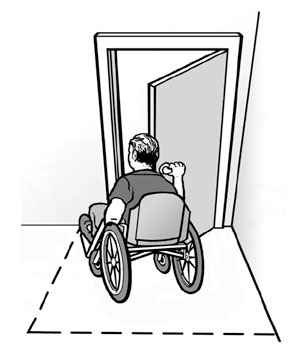 |
|
| YES / NO | 11. Is the full width (minimum 3 feet) of the entire accessible route into and through the business clear of obstacles and trip hazards? |
| YES / NO | 12. Are all the aisles into and through the business free of any objects (e.g., cantilevered display fixtures, trees in container pots, signs) with bottom edges that are between 27 and 80 inches above the walkway and extend more than 4 inches into the aisle? |
 |
|
| YES / NO | 13. Are all objects that hang over the aisles(e.g., seasonal lighting, display merchandise) 80 inches or more above the route? |
| YES / NO | 14. Are the accessible checkout aisles and sales counters staffed during all business hours? |
| YES / NO | 15. Is the full length (minimum 3 feet) of the lowered counters of the accessible checkout aisles and sales counters clear of merchandise and equipment? |
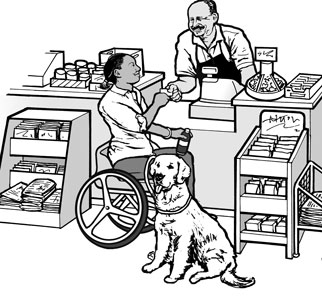 |
|
| YES / NO | 16. Are accessible product demonstration fixtures and areas (e.g., listening stations for recordings, try-out areas for electronics) clear of obstacles that block floor or knee clearance? |
| YES / NO | 17. Are the signs for the accessible restrooms and fitting rooms still readable and mounted next to the latch side of the door, at 5 feet to centerline of the sign? |
| YES / NO | 18. Are accessible public restrooms, toilet stalls, and fitting rooms unlocked when all other facilities are unlocked? Or, if keys are required for all facilities, are the keys for the accessible facilities available in an accessible location? |
| YES / NO | 19. Are the entrances to accessible public restrooms and fitting rooms free of obstacles that block the clear wall and floor space needed for opening the door (between 18 and 42 inches on the latch side of the door, depending on direction of approach and door swing)? Obstacles might include boxes, shelving, or chairs. |
| YES / NO | 20. Is the required floor and wall space inside public restrooms and fitting rooms blocked by obstacles such as trash cans, chairs, or shelving? |
| YES / NO | 21. Are all the accessible dispensers in the public restrooms filled? |
| YES / NO | 22. Are there any obstacles that block access to lift or elevator controls? Obstacles may include trash receptacles or cigarette urns. |
| YES / NO | 23. Are all the business's elevators and lifts in working order? |
| YES / NO | 24. Are all materials that are in alternate formats (e.g., Braille, large print, electronic) up to date and available to customers on request? |
| YES / NO | 25. Have all new employees been informed about the business's accessible features and accessible customer service practices? |
Additional Questions for Individual Businesses
|
For specific information about how to comply with the ADA and reach this nearly untapped audience of people with disabilities, visit the U.S. Department of Justice's ADA Business Connection site at archive.ada.gov; or, call the toll-free ADA Information Line:
800-514-0301 (voice); 833-610-1264 (TTY)
June 2009
Duplication is encouraged.
The Americans with Disabilities Act authorizes the Department of Justice (the Department) to provide technical assistance to individuals and entities that have rights or responsibilities under the Act. This document provides informal guidance to assist you in understanding the ADA and the Department's regulations.
This guidance document is not intended to be a final agency action, has no legally binding effect, and may be rescinded or modified in the Department's complete discretion, in accordance with applicable laws. The Department's guidance documents, including this guidance, do not establish legally enforceable responsibilities beyond what is required by the terms of the applicable statutes, regulations, or binding judicial precedent.
Return to Business Connection Home Page
Last updated: July 6, 2009

